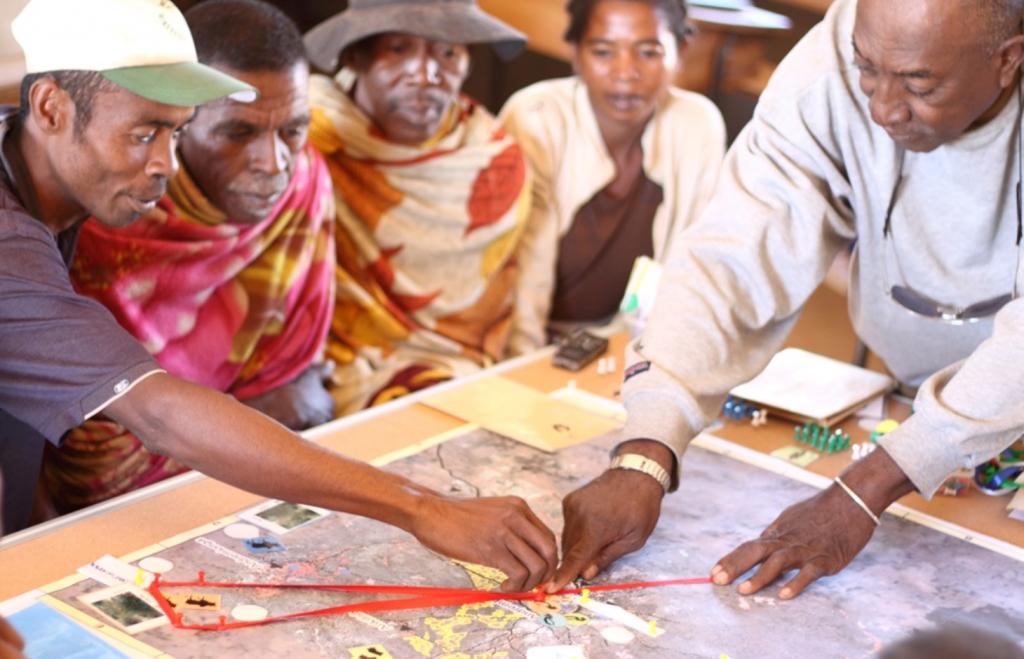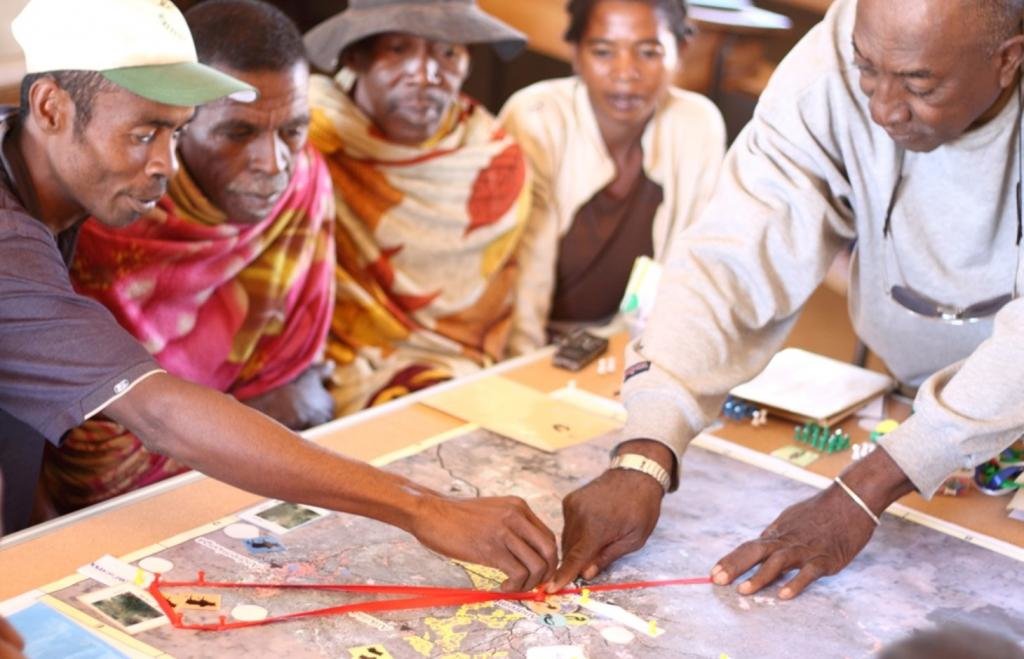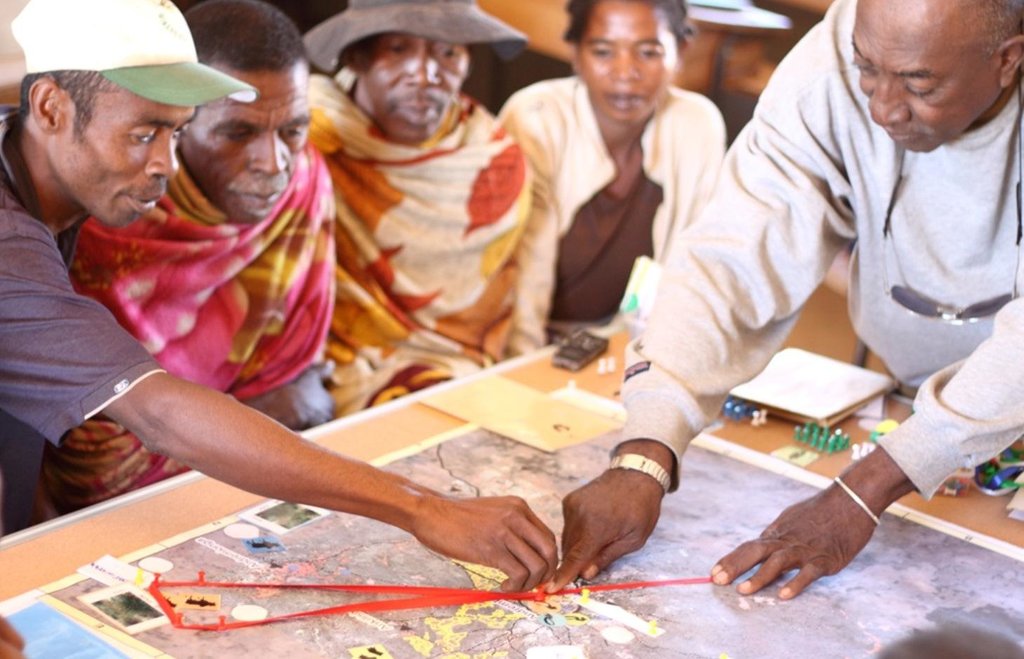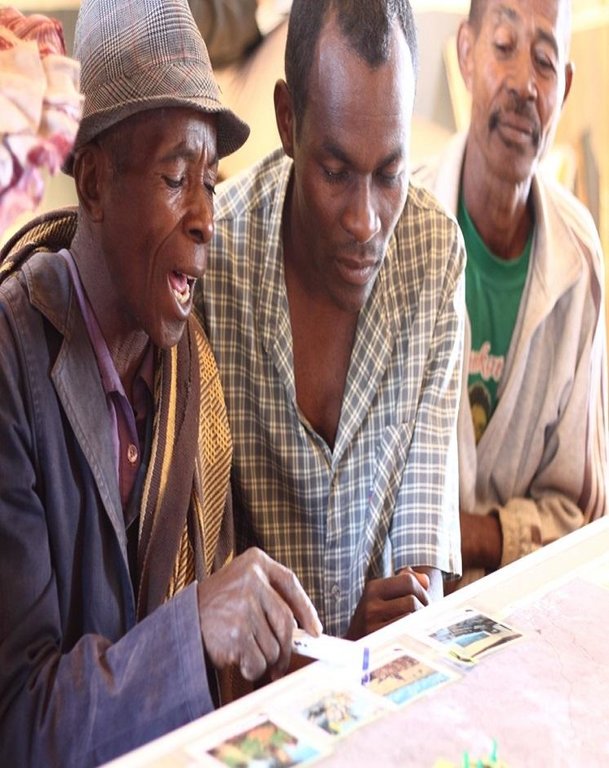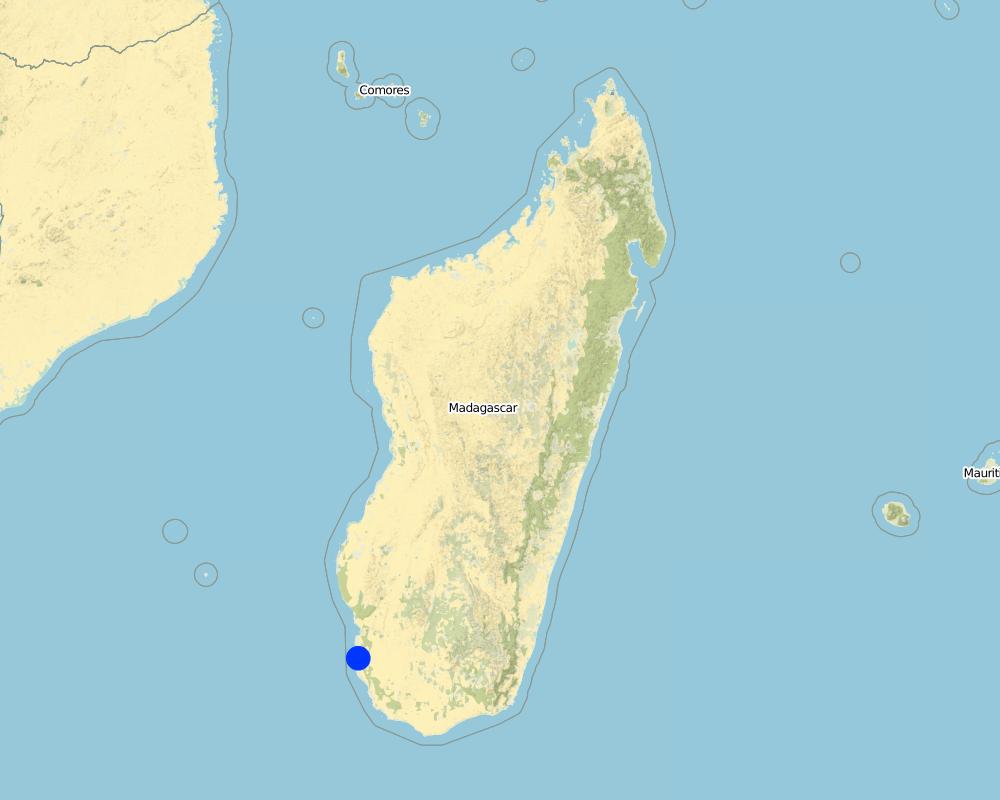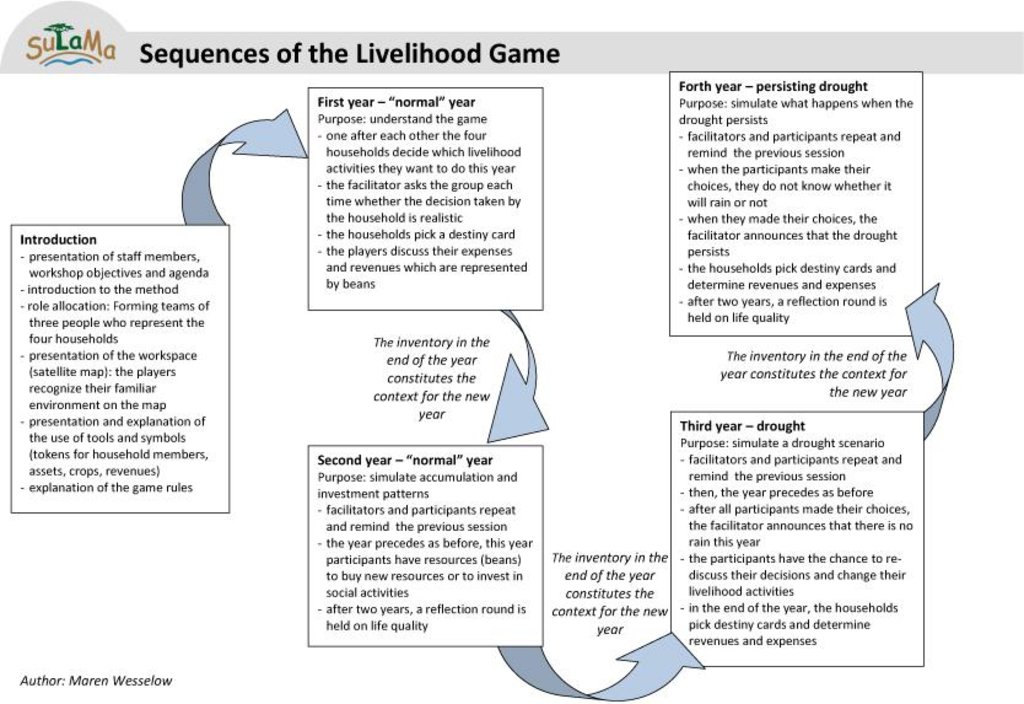Role-Playing Games in Natural Resource Management [Мадагаскар]
- Создание:
- Обновить:
- Составитель: Maren Wesselow
- Редактор: –
- Рецензент: Fabian Ottiger
approaches_2600 - Мадагаскар
Просмотреть разделы
Развернуть все Свернуть все1. Общая информация
1.2 Контактные данные специалистов и организаций, участвующих в описании и оценке Подхода
Специалист по УЗП:
Razafindramonja Mahaleo Claude
mahaleo.claude@gmail.com
Université de Tuléar
Мадагаскар
Специалист по УЗП:
Babarezoto Fenohaja
babarezotofenohaja@gmail.com
Université de Tuléar
Мадагаскар
Специалист по УЗП:
Rakotondranary Jacques
jacques.rak@gmail.com
Université de Antananarivo
Мадагаскар
Название проекта, содействовавшего документированию/оценке Подхода (если применимо)
Sustainable Landmanagement in south-western Madagascar (SuLaMa / GLUES)Название организации (-ий), содействовавших документированию/оценке Подхода (если применимо)
University of Greifswald (University of Greifswald) - ГерманияНазвание организации (-ий), содействовавших документированию/оценке Подхода (если применимо)
University of Antananarivo - МадагаскарНазвание организации (-ий), содействовавших документированию/оценке Подхода (если применимо)
Université de Tuléar - Мадагаскар1.3 Условия, регламентирующие использование собранных ВОКАТ данных
Когда были собраны данные (на местах)?
01/08/2014
Составитель и ответственный/-ые специалист(-ы) согласны с условиями, регламентирующими использование собранных ВОКАТ данных:
Да
2. Описание Подхода УЗП
2.1 Краткое описание Подхода
Participatory simulation to foster stakeholder dialogue in natural resource management, conciliate resource conflicts and enable participatory land use planning
2.2 Подробное описание Подхода
Подробное описание Подхода:
Aims / objectives: Two role-playing games were designed to understand land users' livelihoods strategies in both “normal” but also in times of drought events and cattle raids. The aim was to find out how, and why, livelihood decisions differed between household types in south-western Madagascar. Under the role-playing methodology, land users actively participate through discussing livelihood strategies, negotiating interests, and planning for the future. The methodology proved to be very dynamic, interactive and useful.
Methods: The SuLaMa project is a five-year Malagasy and German research project involving an interdisciplinary team (consortium) that aimed at developing sustainable land use techniques in south-western Madagascar. To validate soft-models that fed into computer-based models on land use change in the region, four workshops were held in four villages on the Mahafaly Plateau. Two groups of land users, with twelve participants each, worked simultaneously in each village: a total number of 96 participated. The games, ‘Livelihood Game’ and ‘Livestock Game', were designed to foster both scientific knowledge production on land use systems, and dialogue with land users. The essence of the methodology is that participants assume the roles of different household types and simulate their annual livelihood activities on a village map. The four household types differed from relatively wealthy (owning cattle; a lot of land) to poor (no cattle, little land). Each household type was represented by two or three participants and roles were allocated randomly.
Stages of implementation: The 'Livelihood Game' covers a time span of four fictive years. Each round represents the household’s annual subsistence decisions. In contrast, the 'Livestock Game' covers just one year with each round encompassing one of three seasons. In the 'Livelihood Game', players have a set of activity options: for example they can locate fields on the map and choose how to cultivate them. Moreover, additional activities like livestock keeping, charcoal making, paid work, collecting/hunting or educating children are available to them. The 'Livestock Game' concentrates on grazing and animal feeding decisions. Each decision is visualized by pictured cards, tokens and symbols - and grazing areas are mapped. While this participatory simulation remains a game, it would be feasible to integrate the methodology into a land use planning process.
Role of stakeholders: Initially, the joint interdisciplinary team conducted a baseline survey using Rapid Rural Appraisal tools to gain a general understanding of local socio-ecologic systems. Following this, a quantitative household survey was carried out in several villages (665 households in total) to analyse household composition and structures. Based on the results, researchers designed the structure of the role-playing games.
Other important information: A crucial precondition was that local communities were well-informed and participation was voluntary. This was achieved by an ‘announcement tour’ where timings were adapted to social, cultural and labour schedules of the local population. The communities were invited to determine the participants according to specific criteria. Participants had to be those who practiced the typical livelihood activities of agriculture and livestock keeping, and who contributed to household decision-making. Furthermore, a balance in terms of gender, age and lineage was requested.
2.3 Фотографии, иллюстрирующие Подход
2.5 Страна/ регион/ место, где применялся Подход
Страна:
Мадагаскар
Административная единица (Район/Область):
Mahafaly Plateau, South-Western Madagascar
Более точная привязка места:
Betioky-Atsimo
Map
×2.6 Даты начала и окончания реализации Подхода
Год начала реализации:
2014
Год окончания (Если Подход больше не применяется):
2015
2.7 Тип Подхода
- в рамках проекта/ программы
2.8 Каковы цели/ задачи Подхода
The Approach focused mainly on other activities than SLM (Participation, stakeholder communication, joint natural resource management, mutual learning)
The community workshops were held in order to (1) validate the researchers’ systems understanding about rural livelihoods and land use activities, and to (2) discuss land users' responses to drought events and cattle raids.
The SLM Approach addressed the following problems: Lack of communication and negotiation between technicians, resource users and scientists. Lack of participation of rural communities in long-term planning and decision-making. Lack of regulations for the use of scarce resources.
2.9 Условия содействующие применению Технологии/ Технологий в рамках Подхода или затрудняющие его
Социальные/ культурные/ религиозные нормы и ценности
- затрудняют
In this rural region, governmental decision-making authorities are mostly absent. Decision-making processes in the local communities follow traditional hierarchies and structures. Men and old people generally have a greater decision-making power than women and young people.
Treatment through the SLM Approach: External actors organized the workshops. They controlled group composition so that it was balanced in terms of gender, age, and lineage.
Нормативно-правовая база (землевладение, права на земле- и водопользование)
- содействуют
Resource and land ownership was a topic during the Role-Playing Games. Problems on conflicts could be detected and discussed, but not always solved.
другие
- затрудняют
Rural livelihoods in the Mahafaly region are vulnerable. Rainfed agriculture and livestock keeping constitute the mainstay of virtually all households. Low and unpredictable precipitation limits agricultural production. Recurrent droughts lead to harvest failures and put a major threat to rural livelihoods. Moreover, people are faced with the problem of organized and armed cattle raiders. In fear of being robbed, herders adjust their grazing grounds and paths.
Treatment through the SLM Approach: Participants could relate the simulation to
real-life. They were enabled to analyse their household management systems and to develop coping strategies to address drought periods.
Participants discussed commonly how to respond to the risk of cattle raids in the region.
3. Участие и распределение ролей заинтересованных сторон
3.1 Заинтересованные стороны, участвующие в реализации Подхода и их роли
- местные землепользователи/ местные сообщества
land users from the villages
When selecting the participants, a balance in gender, age and lignage was asked.
- местные власти
traditional village authorities
- государственные власти (отвечающие за планирование или принятие решений)
- международные организации
German-Malagasy research consortium
Если участвовало несколько заинтересованных сторон, назовите ведущую организацию:
The Livelihood Game and the Livestock Game were designed by researchers on the basis of their previous findings.
3.2 Участие местных землепользователей/ местных сообществ на разных стадиях реализации Подхода
| Участие местных землепользователей/ местных сообществ | Перечислите участников и опишите их вовлеченность | |
|---|---|---|
| инициирование/ мотивация | нет | |
| планирование | нет | |
| выполнение | интерактивное | Villagers participated in the workshops. As compensation for their time, they received a community remuneration. |
| мониторинг/ оценка | интерактивное | After the workshops, participants were asked to give feedback on the methodology. |
| Research | нет |
3.3 Схема реализации (если имеется)
Описание:
The flow chart demonstrates the different sequences of the Livelihood Game at is was played in the workshops 2014. After an introduction, four years were simulated. Each year has a different purpose: The years one and two can be classified as 'normal' years, whereas year three and four are drought years. While year one serves to understand the game, the second year is to simulate accumulation and investment patterns. The third year consitutes a drought year which means harvest failure for the households. In the forth year, participants simulate their behaviour in the scenario of a persisting drought.
Автор:
Maren Wesselow
3.4 Принятие решений по выбору Технологии/ Технологий УЗП
Укажите, кто принимал решение по выбору применяемой Технологии/ Технологий:
- в основном землепользователи при поддержке специалистов по УЗП
Поясните:
During the simulations, land users decided which activities they carried out to feed their (fictive) households. A set of predetermined activities was available to them. The discussions were moderated by a facilitator.
Decisions on the method of implementing the SLM Technology were made by by SLM specialists alone (top-down). The SuLaMa research project decided to use the Role-Playing Games methodology to trigger discussion among and with land users. Within the simulation, land users strongly influenced the game process by decidion on their household activities.
4. Техническая поддержка, повышение компетенций и управление знаниями
4.1 Повышение компетенций/ обучение
Проводилось ли обучение землепользователей/ других заинтересованных лиц?
Да
Укажите, кто проходил обучение:
- землепользователи
- research assistants, WWF staff
Тип обучения:
- в ходе работы
- обмен опытом между фермерами
Тип обучения:
- 'Learning by doing and failing'
Рассматриваемые темы:
Research assistants and WWF staff were trained to facilitate and document the method adequately.
During the workshop sessions, land users gained understanding of the interdependencies of land use and conservation practices and came to reflect the livelihood strategies in their villages.
4.2 Консультационные услуги
Есть ли у землепользователей возможность получать консультации?
Да
Описание/ комментарий:
Participatory simulations, role-playing games; Key elements: Taking on another households' role, Developping livelihood strategies in different scenarios, Discussion, communication and negotiation
4.3 Институциональная (организационная) поддержка
В ходе реализации Подхода были ли организованы новые институциональные структуры или поддержаны уже существующие?
- нет
4.4 Мониторинг и оценка
Являются ли мониторинг и оценка частью Подхода?
Да
Комментарии:
technical aspects were regular monitored by project staff through observations; indicators: data on land use practices were collected
socio-cultural aspects were regular monitored by project staff through observations; indicators: data on human well-being and social conventions (traditions, rituals) were collected
economic / production aspects were regular monitored by project staff through observations; indicators: data on expenses and revenues were collected
area treated aspects were regular monitored by project staff through observations; indicators: spatial decisions were visualised and marked on maps
no. of land users involved aspects were regular monitored by project staff through observations; indicators: in each of the 4 villages 24 land users took part in the workshops
management of Approach aspects were regular monitored by project staff through observations; indicators: qualitative and quantitative data on livelihood strategies were collected
There were few changes in the Approach as a result of monitoring and evaluation: To synchronize the process in the two groups within a village, it was essential to have one observer who could move between the two groups and detect differences. For instance, it was observed that while one facilitator preferred to gather all participants around one big table, the other one arranged separate tables for each household. After the workshop sessions, observers, facilitators and documenters discussed the process and crosschecked the results of different groups. Eventually, it was agreed that it was better to have all participants around one big table. Also household assets, such as poultry or houses, were adopted in the game by the players.
4.5 Научные исследования
Были ли научные исследования частью Подхода?
Да
- households' livelihood strategies
Напишите подробнее и назовите тех, кто выполнял исследования:
An international research consortium conducted the Role Playing Game workshops to validate human decisions in their land use models. However, the approach can be applied for various purposes.
Research was carried out on station
5. Финансирование и внешняя материальная поддержка
5.1 Годовой бюджет мероприятий по УЗП в рамках Подхода
Если точный годовой бюжет неизвестен, укажите примерный диапазон затрат:
- 2000-10000
Комментарий (например, основные источники финансирования/ ключевые доноры):
Approach costs were met by the following donors: international (German Ministry of Education and Research (BMBF)): 100.0%
5.2 Финансирование и внешняя материальная поддержка, предоставляемая землепользователям
Предоставлялась ли землепользователям финансовая/ материальная поддержка для применения Технологии /Технологий?
Да
5.3 Субсидии на отдельные затраты (включая оплату труда)
- оборудование
| Укажите, какие ресурсы были субсидированы | В какой степени | Опишите субсидии подробнее |
|---|---|---|
| инвентарь/ инструменты | профинансированы полностью | maps, toolkits with pictured cards, tokens, etc. |
Если труд землепользователя был существенным вкладом, укажите, был ли этот вклад:
- добровольный
Комментарии:
Participants were paid expense allowance for the workshop days.
5.4 Кредитование
Предоставлялись ли в рамках Подхода кредиты на мероприятия УЗП?
Нет
6. Анализ влияния и заключительные положения
6.1 Влияние Подхода
Сумел ли Подход помочь землепользователям внедрить и поддерживать технологии УЗП?
- Нет
- Да, немного
- Да, умеренно
- Да, существенно
Participants stated that they learned about each other’s livelihood strategies and the long-term impacts. One participant in Andremba stated (2014): “For us this game is like a lesson that makes us understand what happens in our lives. It is a reflection game that makes us think about our lives and our way of life with our subsistence activities and income sources.”
Сумел ли Подход расширить возможности социально и экономически уязвимых групп?
- Нет
- Да, немного
- Да, умеренно
- Да, существенно
People of mixed age, gender and lineage participated in the simulations.
Did other land users / projects adopt the Approach?
- Нет
- Да, немного
- Да, умеренно
- Да, существенно
So far the approach has only be tested once by researchers. However, interested practice organizations may adopt and develop the method in the future.
Did the Approach lead to improved livelihoods / human well-being?
- Нет
- Да, немного
- Да, умеренно
- Да, существенно
The approach primarily triggers land user involvement, but not directly affects their livelihoods.
Did the Approach help to alleviate poverty?
- Нет
- Да, немного
- Да, умеренно
- Да, существенно
Although there is no direct linkage between participation and poverty alleviation, the approach may raise awareness of development and conservation issues and, community learning and empowerment.
6.2 Основные причины, побуждающие землепользователей внедрять УЗП
- нормативно-правовое регулирование (штрафы)/ контроль
The approach may help to negotiate rules and regulations in natural resource management.
- экологическая сознательность
The approach may raise awareness for ecosystem services and their degradation
- Participation, communication
Participation of land users in science and implementation processes as well as communication between
6.3 Долгосрочная устойчивость мероприятий в рамках Подхода
Могут ли землепользователи самостоятельно (без внешней поддержки) продолжать применение того, что было реализовано в рамках Подхода?
- нет
Если нет или нет уверенности, объясните почему:
As the methodology needs preparation and facilitations, some method specialists are required to accompany the process.
6.4 Сильные стороны/ преимущества Подхода
| Сильные стороны/ преимущества/ возможности по мнению землепользователей |
|---|
| The participants understood and generally accepted the game rapidly. They confirmed to have recognized that it was not just a game but a simulation of reality. As all the activities referred to the people’s everyday life, no long introduction or explanation was necessary to start the game. People seemed to feel comfortable in their “roles” and spoke freely about their household decisions. They could actively take part in the game not only by answering to the questions but also by manipulating the game materials on their own. . “This game is easy, because it refers to our daily life, not to something you have created for yourself. This is the reality of our daily lives.” (Participant in Efoetse, August 2014) |
| Сильные стороны/ преимущества/ возможности по мнению составителя или других ключевых специалистов |
|---|
|
The Role Playing Game became vivid and lively by using visualization and communication tools. Complex decisions on land use system could be explained with the help of pictures and symbols from people’s daily life. The tools not only helped to capture the whole systems complexity and open discussions, they also assured mutual understanding and synchronized different agents’ perception. Pictures also helped to achieve a common understanding beyond language barriers. In a region with a high illiteracy rate, these visualization tools can be regarded as measures for empowerment as no writing or reading skills are necessary to take part in the game. Thus, the method is a dynamic and interactive tool for stakeholder integration and awareness raising. |
6.5 Слабые стороны/ недостатки Подхода и пути их преодоления
| Слабые стороны/ недостатки/ риски по мнению землепользователей | Возможные пути их преодоления/снижения? |
|---|---|
| The methodology is time consuming and brings no direct or sudden benefits for land users. | The method could potentially be changed so that results are less research-oriented and more visible for the participants. Now technologies or alternative livelihood activities could be simulated during the game. |
| Слабые стороны/ недостатки/ риски по мнению составителя или ответственных специалистов | Возможные пути их преодоления/снижения? |
|---|---|
| It must be mentioned that a lot of investment and preparation is needed for conducting the workshop successfully. The Role-Playing Game not only requires very specific material and tools, but also a lot of time for development, preparation, team training, testing and on-site execution is required. If the time needed for carrying out the game cannot be planned and tested carefully in advance, it may lead to frustration and disappointment. | The benefits of this approach need to be justified and proved to donors and the extension / advisory services to convince them to invest. |
| Though the methodology was generally accepted and understood, it turned out to be challenging for facilitators and documenters. It requires high communication skills, empathy, and understanding for local conditions and the willingness to listen to the peasants in order to build trust among the group. | To become good facilitators, capacity building and training of extension workers or advisors is needed. |
| The role-playing games methodology is laborious to design and prepare, it usually needs one dedicated institution to initiate and coordinate the workshops. | The only option for continuing this methodology is if a generally-accepted and professional organisation can be found to take on the responsibility in the long term. |
7. Справочные материалы и ссылки
7.1 Методы сбора/источники информации
- выезды на места, полевые обследования
- опросы землепользователей
7.2 Ссылки на опубликованные материалы
Название, автор, год публикации, ISBN:
Wesselow et al. 2015: Participatory Gaming for Sustainable Land Management in the Mahafaly Region. A Practical Guide for Researchers and Practitioners
Где опубликовано? Стоимость?
http://www.sulama.de/files/products/WP5_Product3_Participatory_Gaming_for_SLM_eng.pdf
Ссылки и модули
Развернуть все Свернуть всеСсылки
Нет ссылок
Модули
Нет модулей


